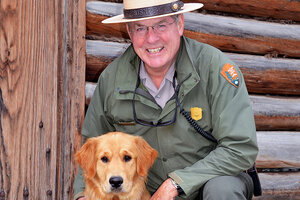A television exec wears a new 'flat hat' – park ranger
After four decades in public TV, John Kerr found himself living his childhood dream, serving at Yellowstone National Park.

John Kerr retired from a job in public television in Boston to become a ranger in Yellowstone National Park.
Courtesy of Franklin and Marshall College
This essay is one in an occasional series provided by our partner organization Encore.org, which is building a movement to tap the skills and experience of those in midlife and beyond to improve communities and the world. Read more stories and share yours at Encore.org/story.
After working for four wonderful decades as a television executive at WGBH TV in Boston, raising three children, and serving my home community, imagine my delight when I found myself living my childhood dream of wearing a “flat hat” and serving as a paid, part-time park ranger in Yellowstone National Park.
It’s my “encore” job in one of the most beautiful places on earth. Suddenly, here I am, hanging out with the world’s top wildlife biologists and fellow rangers, helping to elevate the experience of thousands of visitors to Yellowstone’s remote and beautiful Lamar Valley.
As a noncommissioned ranger, I do not carry weapons nor do I participate in active law enforcement situations in anything other than a support function. However, I serve as an emergency medical technician and participate fully in medical calls, operate and staff our ambulances, and deliver patients to hospitals or to helicopter evacuations, often in emergency situations.
I also officiate at roadside animal “jams” in which visitors observe bears, wolves, or other animals along roadsides. During these “jams,” I keep the visitors at a safe distance, make them welcome, and help explain what they are seeing.
Visitors frequently notice that I am older than most of the rangers they encounter in Yellowstone. They often ask how an “old guy” like me got this job, and how they can do it, too. Usually the questions come from people who are on the brink of retirement or are beginning to consider an encore shift of their own.
I tell them that they should select a national park they like, get to know the district rangers or other personnel there, and investigate what opportunities might be available to them.
America’s wild places and the wildlife that populate them can’t speak for themselves. If we humans don’t act as stewards of nature, who will?
It’s especially important now, in the face of encroaching threats from development.
Visitors from around the world look at a wolf through my scope, or watch a grizzly cross the road, or stop to watch elk or bison, and cry. They often write to thank me later.
But I should thank them for sharing those life-changing moments with me. These are rich and all-too-rare moments that put us in scale with “the wild,” and I never forget them.
The National Park Service is good at recruiting bright and able young rangers – and a few of us who are not so young. But it also uses many older volunteers as campground hosts, guides, and interpreters.
As visitation to national parks increases, unretiring older workers can make an enormous contribution to our national parks to elevate the experience of visitors and supplement existing park staff at a reasonable cost.
We are harnessing our life experience and wisdom to do new work, protect precious natural places, and have fun at the same time.

